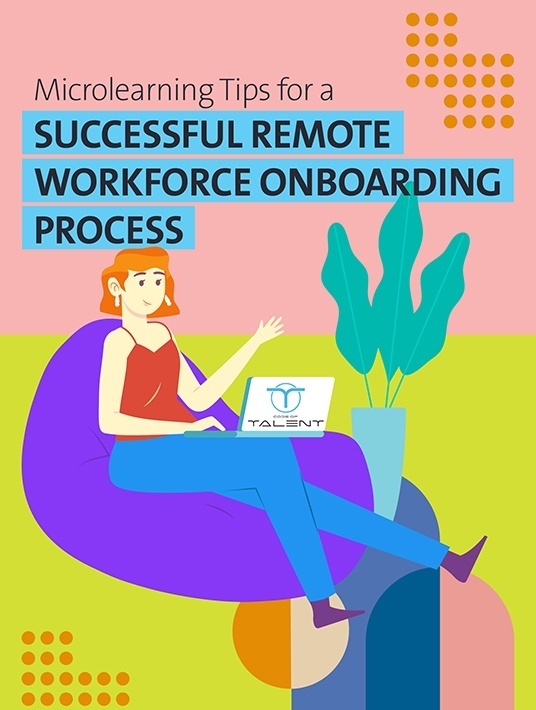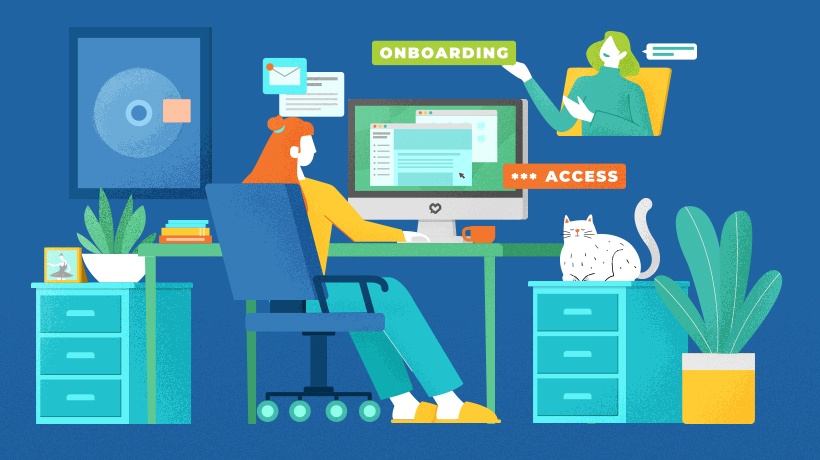Onboarding Best Practices And Microlearning For Remote Workers
Some businesses went into lockdown in the midst of their recruitment, while others had new employees in the middle of their learning and trial phases. The current situation demands that you are agile and versatile in your onboarding processes and adapt to disruptions and the changes in your work ways. This is especially important when you’re dealing with onboarding for remote workers.

Today, many employers are finding it incredibly difficult to adapt to the new reality of remote employment. The complexities of remote onboarding are most commonly encountered by talent management teams and recruiters. You will need to have a remote onboarding strategy in place if you are presently bringing new remote workers into the company and expect to continue recruiting them during the COVID-19 pandemic.
The onboarding strategy for remote workers to deal with the complexities and nuances of a post-COVID-19 world will need to include the onboarding best practices for remote workers in the new normal. Only by making these onboarding best practices part of your remote onboarding strategy will you be able to create engaging microlearning for your remote workers. The following are the best practices you need to follow to successfully onboard new remote workers.
1. Start With Pre-Boarding
The basics stay the same whether you are onboarding the workforce remotely or in-person: you need to build momentum with strong pre-boarding. This is all that occurs from an employment contract agreement to arrival at the workplace—or signing into work from home for the first time.
Your new workers should be able to access everything they need from day one, including learning modules, work-related software, email, and anything else that may need to use. This may sound like a no-brainer, but one of the most prevalent concerns of employees on the first day is accessibility problems. This contact is even more critical with remote onboarding—you want your new recruits to feel connected to the workplace, even though they are not physically
Pre-boarding may seem like a simple admin job, but for your new recruits, missing this crucial phase threatens a smooth first day. The first days are always difficult but the challenge is ten times greater when you’re beginning a new job remotely in the midst of a pandemic. In these circumstances, you wouldn't want your new remote workers to have to worry about getting access to systems or their work mail accounts. It is also critical for new workers to know clearly what to expect when they begin.
All of this can be made easy with microlearning for remote workers; a microlearning platform can help your new, remote workers to develop their skills and get to know the organization in depth—even from afar.
2. Evaluate Your Existing Onboarding Plan
There is a reason your existing onboarding strategy is in place. So, when you’re onboarding remote workers, don't throw it to the side. Begin by carefully assessing and defining the significance of each aspect of your current onboarding process. Focus on the goal, whether it is to provide an industry summary, deliver product training, teach dispute handling best practices, and so on.
Start by asking, “What are the procedures, skills, and information that the new remote employees need to be well versed with to succeed in their jobs?” Once this is established, the same should be communicated to the new workers being onboarded.
Onboarding should have a pre-flight schedule for new recruits—all the stuff they need to do before they can begin their job and excel in their role. Be precise when describing the aim of each stage in the onboarding process.
Doing so will help you transform your strategy into a virtual onboarding sequence more efficiently as well as establish which steps are truly necessary. This is important because there are over 50 tasks in the average onboarding process [1]. Doing away with unnecessary steps will allow you to save time and money.
3. Find The Right Tools For Virtual Onboarding
To successfully onboard remote workers, you need to have the right tools in place at your organization. Once the aim of each onboarding phase has been established, restructure your strategy carefully with certain principles in mind and specify the resources you need to facilitate them.
Typically, several software solutions are needed to successfully onboard remote employees including employee engagement tools, learning management systems (LMS), and video conferencing technology. A microlearning platform ensures access to all of these to your remote workers without the need to switch between software/tools/systems.
4. Ensure A Collaborative Onboarding Process
The second most significant step in virtual onboarding, after strong pre-boarding, is collaboration. A two-part process, collaboration in onboarding requires collaboration in developing content for onboarding followed by collaboration in the onboarding process itself. Both of these are equally significant.
Onboarding is the mechanism by which the new employees are exposed to what they need to learn to do their work. And all that they need to learn can be quite a lot. I talk for the HR or L&D teams here—they simply cannot know all that a new recruit needs to learn. It's unrealistic.
And this takes us to the first aspect of onboarding collaboration: enabling specialists in various subject matters to share their expertise, regardless of the team they belong to.
With a microlearning platform, any remote worker in your company can create and publish learning modules. Moreover, as they move forward, they can seek advice and suggestions from others.
Decentralizing the production of onboarding material makes the lives of everyone simpler. There is less responsibility on the HR or L&D staff, greater trust is shown in the onboarding process by the rest of the organization, and there is greater communication amongst all divisions regarding the new recruits—everybody wins.
In addition to the content development process, collaborative learning should also take place during the onboarding process. Make use of the microlearning platform's interactive functionality to facilitate communication and teamwork.
This involves a discussion platform where new workers can ask questions at any time and give immediate responses to each module when they take each course. The majority of the time, the course instructor or fellow colleagues immediately address questions after each module, course, or task finished.
With these encounters and answers, each of your modules and courses becomes an ongoing process and is a compilation of all the skills, queries, and experiential learning of your past learners.
This allows new recruits to better grasp the courses and develop a sense of belonging. In a virtual onboarding or learning process, which may feel solitary, this is particularly useful. It also enables the author/instructor of the course to refine and iterate the courses, constantly enhancing the consistency of the content of the course.
5. Personalize The Onboarding Process For Each New Hire
Every successful onboarding process is interactive, engaging, and customized to each hire's requirements and preferences. This applies to virtual onboarding as well.
While there are common factors for all new employees in the onboarding experience, you need to have personalized learning paths that provide knowledge and support for each position and their learning requirements and pace to get them ready for their new role. Practically this means tailoring learning material to each new recruit and allowing them the independence and versatility to advance at their own pace.
Bear in mind that any new employee you train will have a slightly distinct style of learning. Visual learners are nearly 65% of the population, auditory learners make up 30%, and only 5% are kinesthetic learners [2].
Since tailoring the process for every new recruit who joins your team is simply not possible, looking to create an onboarding process that caters to each category of learner.
To fit various learning styles, use your virtual platforms, and use a range of training activities. The more involved each new recruit is in the onboarding process, the more productive they will be as a group.
With a microlearning platform, you can use a combination of structured and personalized training material for each remote worker to allow your new hires a degree of versatility in their learning process.
6. Use Checklists To Keep New Hires Engaged
It is easy for new employees to become distracted during their onboarding and training—particularly when they are learning remotely. Use checklists of onboarding tasks to help keep individuals involved and focused, and don't be hesitant to give them the occasional push.
This can be as easy as creating missions within an onboarding learning journey. Checklists and the occasional push, in any case, provide tangible measures of success for learners while generating positive feedback for them.
7. Look For Regular Feedback And Keeping Refining Processes If Needed
This is the last of the virtual onboarding best practices.
Successful onboarding is all about gradual improvement over time. Not only is this true for your new employees, but it also applies to the onboarding process itself. Make sure that you communicate with your new hires about their onboarding experience. Look to understand how they are helped by the process, what works, and what requires improvement.
You will make it easy for new employees to give detailed and meaningful input by asking for a combination of open and specific questions. It allows you to recognize any problems or deficiencies easily and early and improves new employee dedication and engagement.
It also allows your new recruits to know that you actually listen and enables you to strengthen your onboarding process through iteration—even when onboarding virtually.
Conclusion
After the completion of every task on a microlearning platform for remote workers, feedback is immediately requested. This helps to easily detect any problems and keeps details fresh. By addressing feedback on a continuous basis, you are able to iterate and evolve over time.
The process of implementing onboarding best practices for new employees, particularly during periods of uncertainty or stress, is a critical part of building and retaining business capacity. Your onboarding process must keep running no matter what is going on in the world. This is why it is so vital to have a versatile and remote onboarding process in place at your organization.
Once you know the virtual onboarding best practices to follow, it becomes easier to perform and improve the remote onboarding process for new hires. An innovative remote onboarding platform like a microlearning platform can take this up a notch by amplifying the onboarding experience for your new employees through the use of personalized learning paths or onboardings designed for success.
If you are wondering about the benefits microlearning has to offer to your remote workforce onboarding process, download the eBook Microlearning Tips For A Successful Remote Workforce Onboarding Process. Discover the best microlearning tips that will help you succeed in your remote workforce onboarding process stress-free. Join our webinar and learn which microlearning platform features will boost your employee onboarding process!
References:
[1] 2020 Onboarding stats & trends
[2] How to Spot Visual, Auditory, and Kinesthetic-Learning Executives








